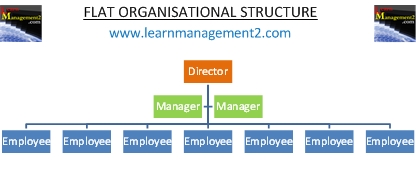Flat Organisational Structure
Introduction
Many organisations have organised their employees into layers. Employees with the most authority (power) will be in the top layers and those with the least will be in the bottom layers. Organisations will structure the layers in a number of different ways. This article is about flat organisational structures, to learn about other types of organisational structure, click on the links at the bottom of this page.
The Flat Structure diagram below illustrates that flat structures have a small number of management layers; many just have one layer.

Layers and Span of Control
In contrast to a tall organisation, a flat organisation will have relatively few layers or just one layer of management. This means that the "Chain of Command" from top to bottom is short and the "span of control is wide". Span of control refers to the number of employees that each manager is responsible for. If a manager has lots of employees reporting to them, their span of control is said to be wide. A manager with a small number of direct reports has a narrow span of control. Due to the small number of management layers, flat organisations are often small organisations.